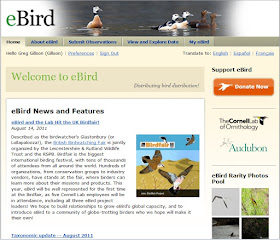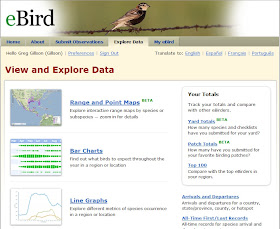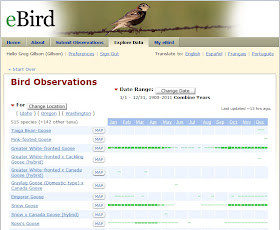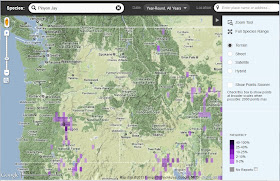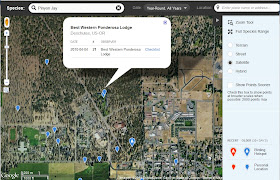 Hooded Oriole, Gaston, Oregon, 26 December 2009 by Greg Gillson.
Hooded Oriole, Gaston, Oregon, 26 December 2009 by Greg Gillson. Many birders got to see this wonderful rare bird at a private feeder, in the tiny burg of Gaston, soon after it was found on the Forest Grove Christmas Bird Count (CBC). My feeling is that there should be time available for each group to go "poach" a rare bird or productive area for an hour or so, outside of their assigned sector (count area). See the previous post (Forest Grove CBC: Join us December 17).
Each sector has certain "target" species that they should try to find, as they may only be found in that sector. Some sectors are mostly driving, some mostly walking. As of this time, all sectors are available and open to request. We need sector leaders, responsible to read the map, track the mileage and time, count all birds seen or heard, and take less experienced ones along for a fun day.
All volunteers should contact me, Greg Gillson, at greg@thebirdguide.com, and let me know what sector you prefer. Please consider being a sector leader.
If you live in the count circle (Roy to Gaston, Forest Grove to west part of Hillsboro) we need feeder watchers. Just keep track of all birds coming to your feeder and keep track of the time you spent watching. Most Anna's Hummingbirds are reported from feeders. If a Hooded Oriole comes to visit, well, one can dream!
Forest Grove Christmas Bird Count, Saturday, December 17, 2011.
Meet at Elmer's Pancake House, 390 SW Adams, Hillsboro, Oregon at 7:00 AM (earlier if having breakfast).
Sector 1)
Northern Forest Grove, NW Hillsboro, Verboort, Roy. Mostly driving.
Target birds: Peregrine Falcon, Prairie Falcon, Herring Gull, Thayer’s Gull, Glaucous Gull, Mourning Dove, Eurasian Collared-Dove, Anna’s Hummingbird, Acorn Woodpecker, Northern Shrike, Horned Lark, Common Raven, American Pipit, Cedar Waxwing, Western Meadowlark, Brown-headed Cowbird.
Sector 2)
Southern Forest Grove, Gales Creek, Stringtown Road, Gales Peak, David Hill. Driving and walking.
Target birds: Redhead, Great Egret, Sharp-shinned Hawk, Red-breasted Sapsucker, Northern Shrike, Common Raven, Western Bluebird, Brown-headed Cowbird, Lesser Goldfinch.
Sector 2A-optional)
Roderick Road. Steep, rough logging road walking up to 5 miles into clearcuts/forest.
If enough people, assign to separate group, otherwise include in Sector 2.
Target birds: Ruffed Grouse, Blue Grouse, Mountain Quail, Barred Owl, Northern Pygmy-Owl, Hairy Woodpecker, Pileated Woodpecker, Hutton’s Vireo, Gray Jay, Chestnut-backed Chickadee, Brown Creeper, Hermit Thrush, Townsend’s Warbler, Red Crossbill, Evening Grosbeak
Sector 3A)
Hagg Lake (West side) and nearby areas. Site guide. Driving and walking.
Sector 3B)
Hagg Lake (East side). Mostly walking up to 6 miles of trails and park area.
Target birds for all of Hagg Lake: Eurasian Wigeon, Greater Scaup, Common Goldeneye, Ruffed Grouse, Common Loon, Western Grebe, Horned Grebe, Eared Grebe, Spotted Sandpiper, California Gull, Herring Gull, Red-breasted Sapsucker, Hairy Woodpecker, Pileated Woodpecker, Common Raven, Chestnut-backed Chickadee, Brown Creeper, American Dipper, Purple Finch.
Sector 3C)
Logging Roads on Scoggins Creek Road above Hagg Lake. 2-1/2 miles driving logging road and walking another 3 miles of rough logging roads.
Target birds: Blue Grouse, Mountain Quail, Sharp-shinned Hawk, Northern Pygmy-Owl, Barred Owl, Red-breasted Sapsucker, Hairy Woodpecker, Pileated Woodpecker, Hutton’s Vireo, Gray Jay, Western Bluebird, Hermit Thrush, Townsend’s Warbler, Red Crossbill, Purple Finch, Evening Grosbeak
Sector 4)
Patton Valley. Mostly driving.
Target birds: White-tailed Kite, Sharp-shinned Hawk, Red-shouldered Hawk, Rough-legged Hawk, Ring-necked Pheasant, Mourning Dove, Red-breasted Sapsucker, Northern Shrike, Common Raven, Chestnut-backed Chickadee, Western Bluebird, Townsend's Warbler, White-throated Sparrow, Purple Finch.
Sector 5)
Spring Hill Road, Laurelwood, Bald Peak, Dixon Mill Road (both sides), Firdale Road. Mostly driving.
Target species: Ruffed Grouse, Sharp-shinned Hawk, Rough-legged Hawk, Red-breasted Sapsucker, Northern Shrike, Western Bluebird, Hermit Thrush, Chestnut-backed Chickadee, American Pipit, White-throated Sparrow, Brown-headed Cowbird, Lesser Goldfinch.
Sector 5A-optional)
Metro’s Chehalem Ridge property on Dixon Mill Road may be assigned to a separate team with special permission to enter.
Sector 6)
Fernhill Wetlands and surrounding areas. Walking and driving.
Target species: Trumpeter Swan, Wood Duck, Eurasian Wigeon, Gadwall, Ring-necked Pheasant, California Quail, Western Grebe, Horned Grebe, Great Egret, Bald Eagle, Sharp-shinned Hawk, Red-shouldered Hawk, Rough-legged Hawk, Peregrine Falcon, Merlin, Wilson’s Snipe, Mew Gull, Ring-billed Gull, California Gull, Herring Gull, Thayer’s Gull, Western Gull, Mourning Dove, Northern Shrike, Common Raven, Marsh Wren, Western Bluebird, American Pipit, Yellow-rumped Warbler, Lincoln’s Sparrow, White-throated Sparrow, Swamp Sparrow, Western Meadowlark, Brown-headed Cowbird, Purple Finch, Lesser Goldfinch.
Sector 7)
Jackson Bottom and surrounds. Lots of wet walking if Jackson Bottom is not flooded, otherwise mostly driving.
Target species: Trumpeter Swan, Wood Duck, Great Egret, Sharp-shinned Hawk, Red-shouldered Hawk, Merlin, Peregrine Falcon, Ring-necked Pheasant, California Quail, Wilson’s Snipe, California Gull, Herring Gull, Anna’s Hummingbird, Northern Shrike, Marsh Wren, Western Bluebird, Cedar Waxwing, Yellow-rumped Warbler, Orange-crowned Warbler, Savannah Sparrow, Lincoln’s Sparrow, White-throated Sparrow.
Sector 8)
Forest Grove. Walking in town. This is the official "poaching" team. After covering town last year, Tim Rodenkirk and I poached at Fernhill Wetlands and Hagg Lake. Combined with the early morning owling we did, we ended the day personally recording 91 of the 117 total count species.
Target birds: Merlin, Eurasian Collared-Dove, Anna’s Hummingbird, Acorn Woodpecker, Brown Creeper, Cedar Waxwing, Townsend’s Warbler, White-throated Sparrow.










